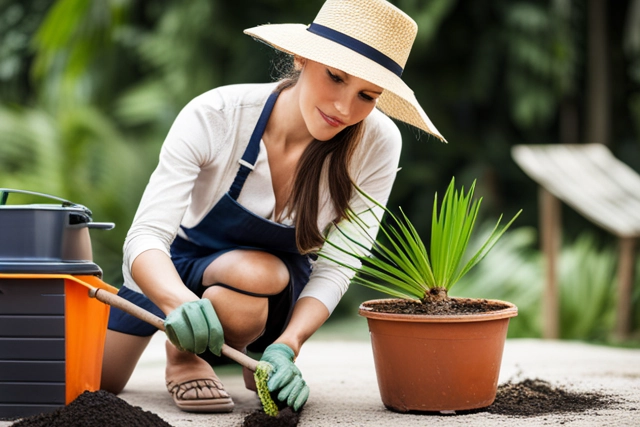Palm trees, with their iconic tropical charm, are a favourite among indoor and outdoor plant enthusiasts. However, to ensure these plants flourish, they require proper attention and care. An integral part of this care is the process of transplanting or repotting, which can seem intimidating to many. This article aims to simplify this process, offering a detailed guide on the timing and techniques of repotting palm trees.
Understanding the Nature of Palm Trees
Before we delve into the process of repotting, it’s important to appreciate the unique nature of palm trees. Palms are an incredibly diverse group, boasting over 2,500 species globally. Despite their variety, most palms have common features. They possess a single, unbranched stem with large, evergreen leaves at the top. Palms are monocots, which means they don’t have a secondary root system. Instead, they have a cluster of primary roots that extend directly from the stem base. This root structure is a key factor to consider during repotting.
Identifying the Right Time to Repot Palm Trees
The timing of repotting is critical for your palm tree’s health and growth. Generally, the optimal time to repot a palm tree is during its active growth phase, usually in spring or early summer. This timing allows the palm to recover swiftly from the stress of repotting and establish itself in the new pot before the slower growth period in autumn and winter.
Indications that your palm tree is ready for repotting include:
1. Root Overcrowding: If you observe roots emerging from the drainage holes or circling the soil surface, it’s a clear indication that your palm is outgrowing its current pot.
2. Stunted Growth: If your palm’s growth has noticeably slowed or halted, it could be due to insufficient space for root expansion.
3. Increased Watering Frequency: If you find yourself watering your palm more often, it could be because the roots have occupied so much space that water runs straight through the pot.
Techniques for Repotting Palm Trees
Having established when to repot, let’s explore the techniques. Here’s a step-by-step guide:
1. Get New Pot Ready: Select a new pot that is 2-3 inches wider than the current one. Make sure it has sufficient drainage holes. Add a layer of potting soil designed for palms or a well-draining mix of peat, sand, and perlite at the bottom.
2. Extract the Palm from the Old Pot: Hydrate your palm thoroughly a day before repotting to ease the soil. Carefully tilt the pot sideways and gently remove the palm, taking care not to harm the roots.
3. Examine and Trim the Roots: Inspect the root ball. If you spot any dead, diseased, or excessively tangled roots, trim them with a clean, sharp pair of scissors.
4. Position the Palm in the New Pot: Centre the palm in the new pot. The root ball’s top should be just below the pot’s rim. Adjust the soil quantity as needed to achieve the correct height.
5. Add Soil: Fill the space around the root ball with potting soil, pressing gently to eliminate air pockets. Leave some space at the top for watering.
6. Hydrate and Nurture Your Palm: After repotting, hydrate your palm thoroughly. Position it in a spot with indirect sunlight and maintain your regular watering and feeding schedule.
Planting a Palm
Conclusion
Transplanting palm trees is a crucial part of their care and maintenance. By understanding the timing and techniques of repotting, you can ensure your palms continue to bring a touch of
tropical elegance to your surroundings for many years.
Remember, the secret to successful repotting lies in the timing, the selection of the new pot and soil, and the post-repotting care. With these guidelines, even a beginner gardener can confidently transplant their palm trees and enjoy the vibrant, green growth that follows.
Transplanting might seem like a tough task, but it is a rewarding one. It offers a chance to closely inspect your palm for any signs of disease or pests and to refresh the growing medium, contributing to the overall health and longevity of your palm. So, don’t shy away from this essential gardening task. Embrace it, and watch your palms flourish.
Remember, each palm tree is unique, and so are its care requirements. While this guide provides general advice on transplanting palm trees, it’s always a good idea to research the specific needs of your palm species or seek advice from local nurseries or extension services.
In the end, successful gardening is about more than just following steps; it’s about understanding and responding to the needs of your plants. So, keep observing, keep learning, and keep growing. Happy gardening!




